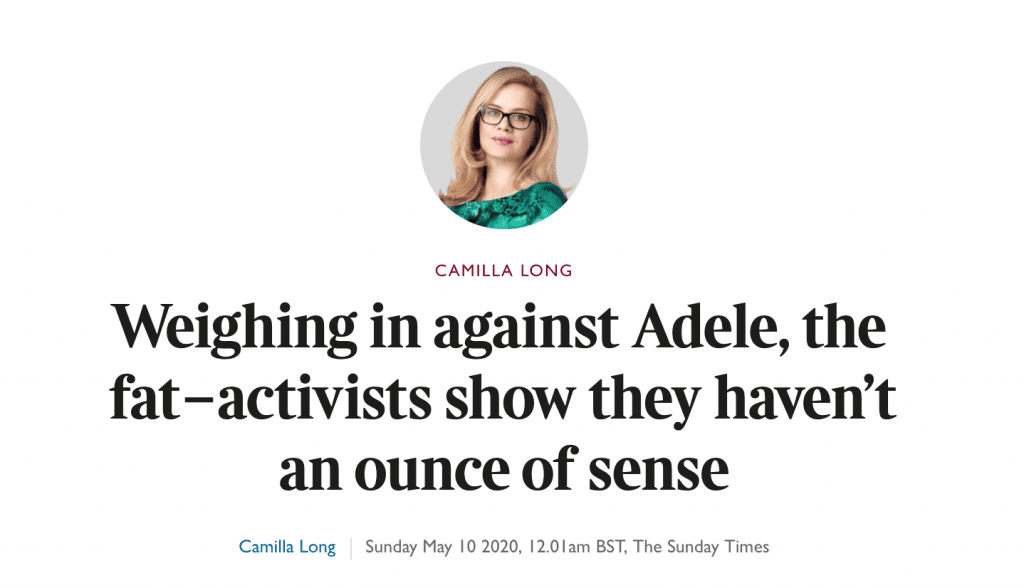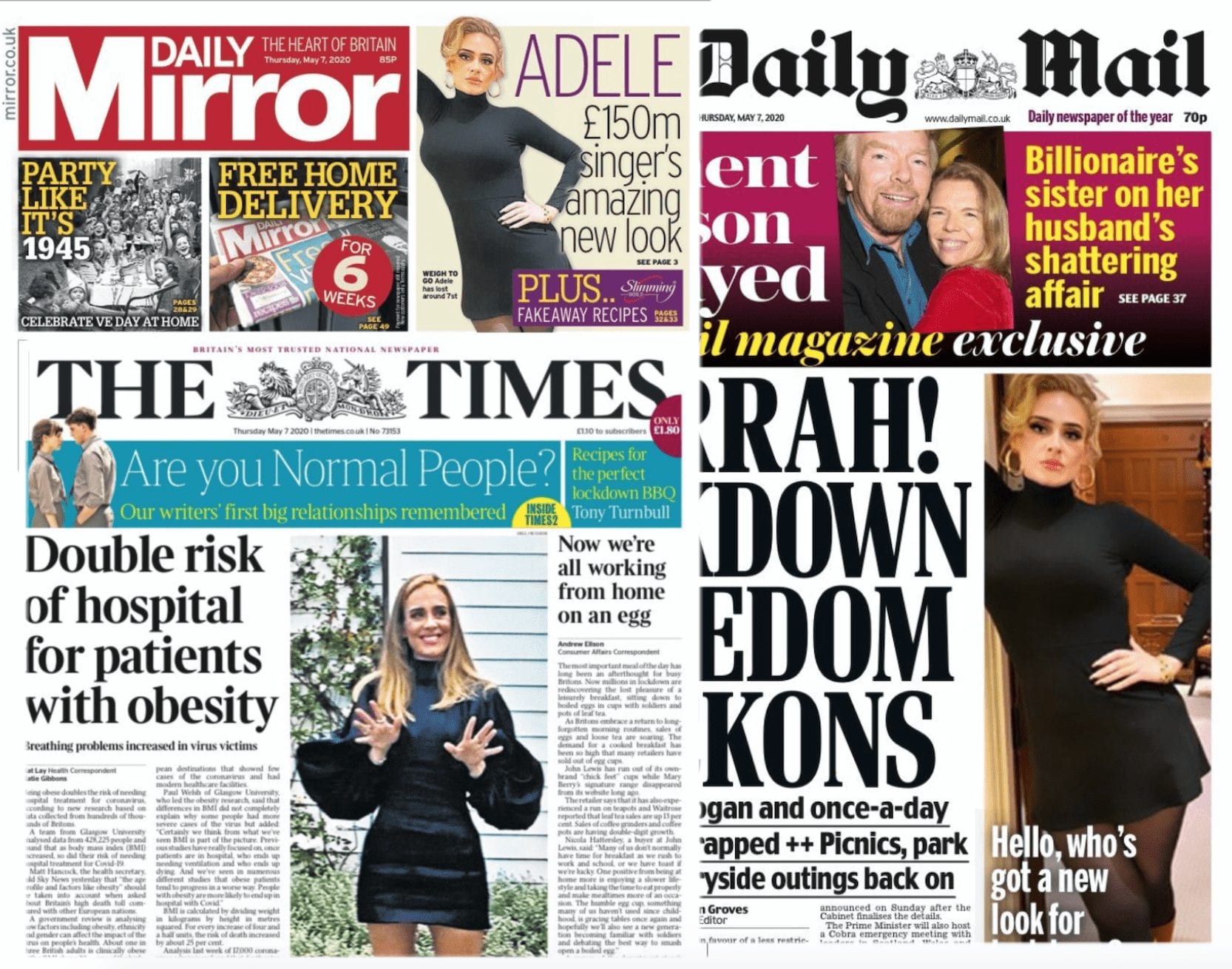From tabloids to broadsheets, what are our newspapers saying about Adele’s weight loss? In turn, what does this reveal about society’s attitudes to female body image?
In every mainstream British newspaper this week, there has been an article about Adele and her new look following a singular Instagram post on her 32nd birthday. Each one reveals a huge amount about the newspapers attitudes towards body image and by extension their readers.
Adele has been praised for her ‘glow-up’, new ‘revenge bod’, and looking ‘happier than ever’. The usual tabloid suspects include: The Sun, The Mirror, and The Daily Mail. The Mirror alone has published over fifteen articles about Adele’s weight loss in the past week. They go into extensive detail, advocating the Sirtfood Diet, eating 1000 calories a day. That’s half of the NHS’s recommended intake for women! The concept of her weight loss has been a gradual process rather than an instant 7st change. The previously mentioned papers have alluded to her divorce last year as being the key factor to her weight loss.
The idolisation of the slim body is undeniable, but albeit expected, by the tabloids. Yet, The Daily Mail goes further. They have dedicated an entire piece to compare Adele to other ‘A-List celebs’. Her eyebrows are the same as Emily Blunt, her hair the same as Jennifer Lawrence, and she has finally achieved the thigh gap of Ayda Field, Alison Boshoff writes. It even goes so far as comparing Nicole Richie’s upbringing in a mansion to Adele’s, growing up in ‘grotty flats [raised] by a single mum’, yet somehow they have a similar dress. The underlying shaming of these tabloids despite appearing to praise Adele for her ‘achievements’ is farcical. Yes, she may look ‘good’ but this never seems to be enough in the eyes of the audience.
We, the reader, MUST remember that:
Adele actually bought her way into beauty with hypnotherapy and Cameron Diaz’s chef.
She may have a designer dress but we ought not forget her less privileged upbringing.
She may now look like Sarah Paulson, but how unoriginal (and she definitely got a facelift).
Adele will never win in the eyes of these tabloids.
The message this sends to their readers is clear: you should look like Adele, or crave to look like Adele. But if you don’t? It’s just because you don’t live in LA and don’t have the ‘willpower’ to stick to her 1000 calorie diet. You have two choices, deify her or hate her for her class-climbing LA life. But either way, her body, and her lifestyle choices are yours to have an opinion on and project your societally determined insecurities onto.
On the flip side, The Telegraph’s Rebecca Reid seemed to be in the firing line for her article titled ‘Why the photo of a new, slimmer Adele makes women like me feel uncomfortable’. Despite the provocative title, Reid nicely summarises the position of a weight-conscious woman fighting to be a feminist in 2020. She acknowledges she is jealous, and wishes she didn’t care, thus making her feel like a bad feminist.

This article actually does not reflect on Adele to any degree. Adele has not, in the space of one Instagram picture, made Reid insecure about her own body. Instead, the commentators, the twitter critics, the tabloids, and journalists themselves have made Reid insecure. They’ve put her in the mindset where she feels she needs to compare her body to a complete stranger. This is something I think every Western woman can relate to, regardless of size, age, or ethnicity.
The vilification of Reid does no more than reinstate this too. This is exemplified by @Purify_toast17: “If Rebecca Reid would put the snacks down, she could look like Adele too”. And @Mbwoyh1: “Google Rebecca Reid and you’ll find out why lool she’s insecure as f**k”. In some ways, Reid, like Adele, cannot win.
Peta Bee wrote for The Times, detailing how to lose weight “like Adele“, consulting Dr Duane Mello, a dietician and professor. The same newspaper also published an article written by Camilla Long. It hits out at anyone who doesn’t look like Adele, whilst also shaming Adele herself. She remarks that the body positive movement acts “as a morally superior form of ‘feminism’ that encourages women to destroy themselves, one Viennese whirl at a time”. Long then personally criticises Adele, “She can pay her way out of fat misery if she wants to, and by the look of it she has”.

Long perceives herself to be the pinnacle of feminism. She remarks that society is “attacking people for wanting to be healthy, demanding women remain imprisoned by their own fat to make everyone else feel better”.
Long’s surety that being skinny is synonymous with being healthy highlights a deeply problematic vein in the discourse surrounding female body image. The disregard to anorexia in contrast with obesity is not only representative in conversation but is also reflected in funding and support.
Irony can also be found in The Guardian. Arwa Mahdawi writes an article to express why people shouldn’t talk about Adele’s weight loss. She makes a number of valuable insights into the discourse surrounding female body image in the wake of Adele’s weight loss. “Despite all the progress there has been around gender equality much of the world is still more interested in what goes into a woman’s mouth than what comes out of it.”
Words By Izzy MacKellar
